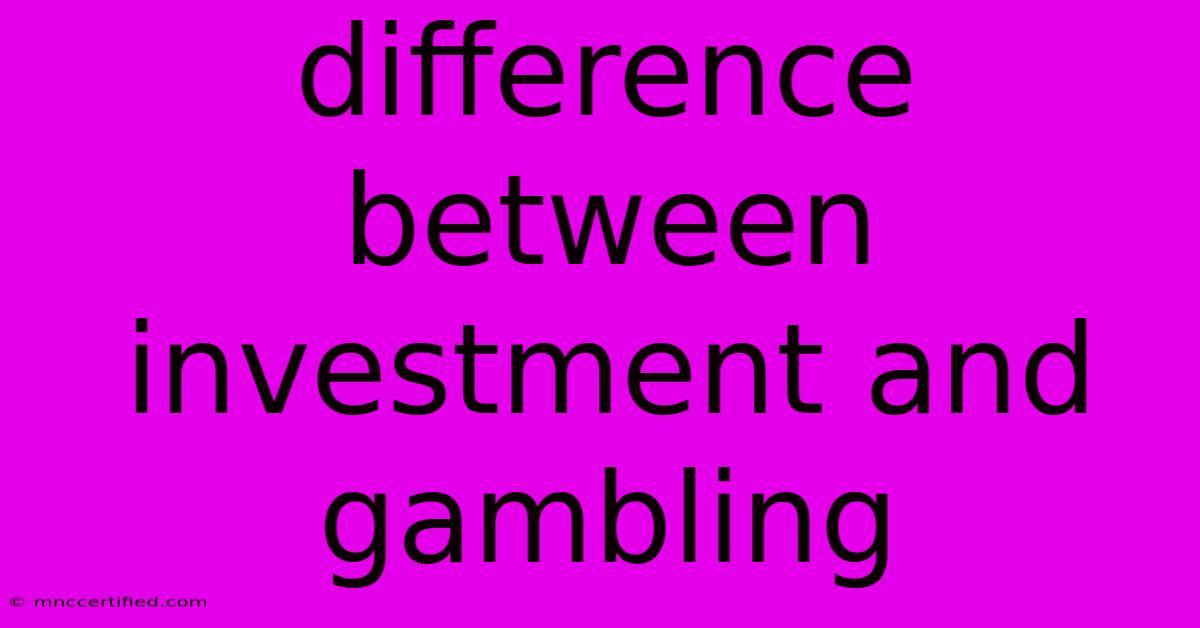Difference Between Investment And Gambling

Table of Contents
Investing vs. Gambling: Know the Difference Before You Take the Plunge
The terms "investment" and "gambling" are often used interchangeably, but they represent vastly different approaches to managing your money. While both involve risk, the key distinction lies in the underlying factors driving potential gains. Understanding this difference is crucial for making informed financial decisions and achieving your financial goals.
Investment: Building a Future, Brick by Brick
Investment is a strategic approach to growing your wealth over time. It involves allocating money to assets like:
- Stocks: Owning a portion of a company, with the potential for dividends and capital appreciation.
- Bonds: Lending money to a government or corporation, receiving regular interest payments.
- Real Estate: Owning property, hoping for appreciation in value and potential rental income.
- Mutual Funds/ETFs: Diversified portfolios of stocks or bonds managed by professionals.
Investing typically involves research, due diligence, and a long-term perspective. You aim to invest in assets with intrinsic value, meaning their worth is supported by underlying factors like:
- Earnings potential of a company (stocks)
- Financial stability of a government or corporation (bonds)
- Market demand for a property (real estate)
Key characteristics of investing:
- Focus on long-term growth.
- Involves research and analysis.
- Aims for returns based on fundamental value.
- Generally carries lower risk than gambling when done responsibly.
Gambling: Chasing the Quick Win
Gambling, on the other hand, is a game of chance. It involves wagering money on an event with an uncertain outcome, hoping for a quick return. Examples include:
- Casino games: Slots, roulette, blackjack, poker.
- Lotteries: Winning a large sum based on random number selection.
- Sports betting: Placing bets on the outcome of sporting events.
Gambling relies on luck and probability. There's no underlying intrinsic value driving the potential gains. The odds are often stacked against the player, leading to a higher risk of losing money.
Key characteristics of gambling:
- Focus on short-term gains.
- Driven by luck and chance.
- Higher risk of losing money.
- Can be addictive and lead to financial problems.
The Line Between Investment and Gambling: Where Does It Blur?
The distinction between investment and gambling can become blurred in certain cases. For example:
- Day trading: Buying and selling stocks rapidly in an attempt to profit from short-term price fluctuations. This can resemble gambling due to the high risk and focus on quick profits.
- High-yield investments: These investments often offer higher returns but carry a greater risk of losing money. While not technically gambling, the potential for large losses can make them seem more like a gamble.
It's essential to exercise caution with any investment that relies heavily on speculation, hype, or promises of unrealistic returns.
Investing for the Future: A Wise Choice
While gambling can provide a fleeting thrill, investing is a proven path to building wealth over time. By understanding the differences and embracing a long-term approach, you can make informed financial decisions that help you achieve your goals and secure a brighter future.
Remember:
- Do your research: Invest in what you understand and be prepared to learn.
- Diversify your portfolio: Spread your risk by investing in different asset classes.
- Be patient: Investments take time to grow, so don't expect overnight riches.
- Seek professional advice: If you're unsure about investing, consider consulting a financial advisor.
By approaching your finances with knowledge and discipline, you can turn your investments into a powerful tool for achieving your financial goals.

Thank you for visiting our website wich cover about Difference Between Investment And Gambling. We hope the information provided has been useful to you. Feel free to contact us if you have any questions or need further assistance. See you next time and dont miss to bookmark.
Featured Posts
-
Donald Trumps Term Dates And Details
Nov 07, 2024
-
Ballot Box Tough On Crime Trend
Nov 07, 2024
-
Champions League Inter Milan Vs Arsenal Preview
Nov 07, 2024
-
Bitcoin Price Real Time Indicator During The Pandemic
Nov 07, 2024
-
Neutral Ground Bonding Plug For Generator
Nov 07, 2024